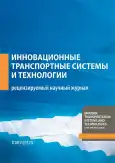Магнитные и транспортные характеристики элементов ВТСП генератора на основе незамкнутых сверхпроводящих обмоток
- Авторы: Мартиросян И.В.1, Александров Д.А.1, Покровский С.В.1
-
Учреждения:
- Национальный исследовательский ядерный университет «МИФИ»
- Выпуск: Том 11, № 1 (2025)
- Страницы: 43-59
- Раздел: Оригинальные статьи
- URL: https://bakhtiniada.ru/transj/article/view/289343
- DOI: https://doi.org/10.17816/transsyst660871
- ID: 289343
Цитировать
Полный текст
Аннотация
Цель. Сравнение магнитных и транспортных характеристик рейстрек-катушек и незамкнутых ВТСП обмоток.
Методы. Численный анализ выполнен методом конечных элементов в среде моделирования Comsol Multiphysics.
Результаты. Для этих геометрий, характерных в электромагнитных системах ВТСП генератора, выполнен расчет распределений токов, магнитных полей и температур в условиях воздействия постоянного транспортного тока, а также выполнен расчет потерь на переменном токе при различных амплитудах и частотах токовой нагрузки в условиях охлаждения жидким азотом.
Заключение. В условиях охлаждения жидким азотом рейстрек-катушки обладают лучшими магнитными и транспортными характеристиками в сравнении с незамкнутыми кольцевыми ВТСП обмотками, на что решающее влияние оказывает их геометрический фактор. Наиболее выгодной конфигурацией обмотки элементов ВТСП генератора при азотном охлаждении является рейстрековая катушка.
Полный текст
Открыть статью на сайте журналаОб авторах
Ирина Валерьевна Мартиросян
Национальный исследовательский ядерный университет «МИФИ»
Автор, ответственный за переписку.
Email: mephizic@gmail.com
ORCID iD: 0000-0003-2301-1768
SPIN-код: 3368-8809
кандидат физико-математических наук, инженер-исследователь
Россия, МоскваДмитрий Александрович Александров
Национальный исследовательский ядерный университет «МИФИ»
Email: cfrfcfrfdima123@gmail.com
ORCID iD: 0009-0001-7383-0094
SPIN-код: 5365-6190
инженер-исследователь
Россия, МоскваСергей Владимирович Покровский
Национальный исследовательский ядерный университет «МИФИ»
Email: sergeypokrovskii@gmail.com
ORCID iD: 0000-0002-3137-4289
SPIN-код: 6643-7817
кандидат физико-математических наук, заведующий научно-исследовательской лаборатории
Россия, МоскваСписок литературы
- Barnes PN, Sumption MD, Rhoads GL. Review of high power density superconducting generators: Present state and prospects for incorporating YBCO windings. Cryogenics. 2005;45(10):670–86. doi: 10.1016/j.cryogenics.2005.09.001
- Haran KS, Kalsi S, Arndt T, et al. High power density superconducting rotating machines–development status and technology roadmap. Superconductor Science and Technology. 2017;30(12):123002. doi: 10.1088/1361-6668/aa833e
- Kalsi SS, Weeber K, Takesue H, et al. Development status of rotating machines employing superconducting field windings. Proceedings of the IEEE. 2004;92(10):1688–704. doi: 10.1109/JPROC.2004.833676
- Kim C, Sung HJ, Go BS, et al. Design, Fabrication, and Testing of a Full-Scale HTS Coil for a 10 MW HTS Wind Power Generator. IEEE Transactions on Applied Superconductivity. 2021;31(5):1–5. doi: 10.1109/TASC.2021.3059223
- Song X, Mijatovic N, Kellers J, et al. A Pole Pair Segment of a 2-MW High-Temperature Superconducting Wind Turbine Generator. IEEE Transactions on Applied Superconductivity. 2017;27(4):1–5. doi: 10.1109/TASC.2017.2656778
- Gamble B, Snitchler G, MacDonald T. Full Power Test of a 36.5 MW HTS Propulsion Motor. IEEE Transactions on Applied Superconductivity. 2011;21(3):1083–8. doi: 10.1109/TASC.2010.2093854
- Moon H, Kim Y-C, Park H-J, et al. An introduction to the design and fabrication progress of a megawatt class 2G HTS motor for the ship propulsion application. Superconductor Science and Technology. 2016;29(3):034009. doi: 10.1088/0953-2048/29/3/034009
- Sivasubramaniam K, Zhang T, Lokhandwalla M, et al. Development of a High Speed HTS Generator for Airborne Applications. IEEE Transactions on Applied Superconductivity. 2009;19(3):1656–61. doi: 10.1109/TASC.2009.2017758
- Terao Y, Seta A, Ohsaki H, et al. Lightweight Design of Fully Superconducting Motors for Electrical Aircraft Propulsion Systems. IEEE Transactions on Applied Superconductivity. 2019;29(5):1–5. doi: 10.1109/TASC.2019.2902323
- Hahn S, Park DK, Bascunan J, Iwasa Y. HTS Pancake Coils Without Turn-to-Turn Insulation. IEEE Transactions on Applied Superconductivity. 2011;21(3):1592–5. doi: 10.1109/TASC.2010.2093492
- Zanegin SY, Ivanov NS, Shishov DM, et al. AC losses test of HTS racetrack coils for HTS motor winding. J. Phys.: Conf. Ser. 2020;1559(1):012142. doi: 10.1088/1742-6596/1559/1/012142
- Zhang G, Chen B, Song F, et al. Optimal Design of an Innovative High Temperature Superconducting Generator With the Evaporative Cooling Stator and the Magnetic Flux Oriented Rotor. IEEE Transactions on Applied Superconductivity. 2007;17(2):1545–8. doi: 10.1109/TASC.2007.898197
- Gao Y, Wang W, Wang X, et al. Design and Study of a 2G HTS Synchronous Motor With Brushless HTS Flux Pump Exciters. IEEE Transactions on Applied Superconductivity. 2019;29(5):1–5. doi: 10.1109/TASC.2019.2898505
- Jeon H, Lee J, Han S, et al. PID Control of an Electromagnet-Based Rotary HTS Flux Pump for Maintaining Constant Field in HTS Synchronous Motors. IEEE Transactions on Applied Superconductivity. 2018;28(4):1–5. doi: 10.1109/TASC.2018.2822704
- Alexandrov DA, Martirosian IV, Pokrovskii SV, et al. Energy capacity and energy losses of inductive energy storage device based on composite HTS tapes MTST. 2024;10(2):215–30. doi: 10.17816/transsyst632274
Дополнительные файлы
















